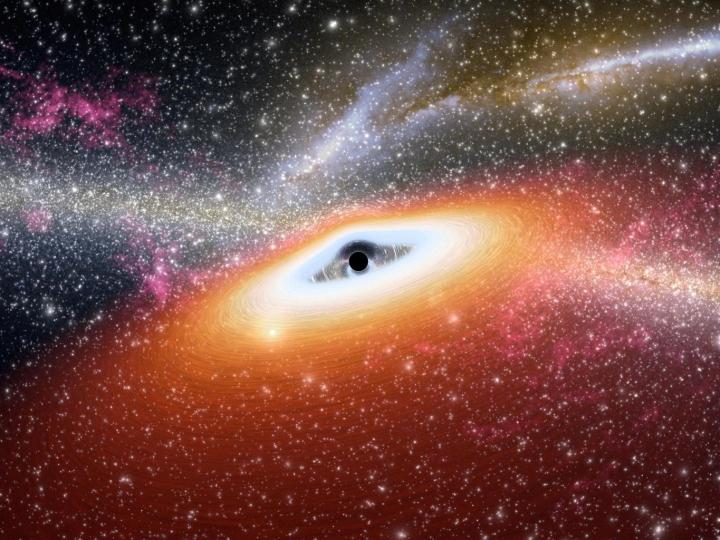Tel Aviv University-led team discovers new way supermassive black holes are 'fed'

This is an artistic impression of a gas disk feeding a massive black hole while emitting radiation. Credit: NASA
Supermassive black holes weigh millions to billions times more than our sun and lie at the center of most galaxies. A supermassive black hole several million times the mass of the sun is situated in the heart of our very own Milky Way.
Despite how commonplace supermassive black holes are, it remains unclear how they grow to such enormous proportions. Some black holes constantly swallow gas in their surroundings, some suddenly swallow whole stars.
But neither theory independently explains how supermassive black holes can “switch on” so unexpectedly and keep growing so fast for a long period.
A new Tel Aviv University-led study published today in Nature Astronomy finds that some supermassive black holes are triggered to grow, suddenly devouring a large amount of gas in their surroundings.
In February 2017, the All Sky Automated Survey for Supernovae discovered an event known as AT 2017bgt. This event was initially believed to be a “star swallowing” event, or a “tidal disruption” event, because the radiation emitted around the black hole grew more than 50 times brighter than what had been observed in 2004.
However, after extensive observations using a multitude of telescopes, a team of researchers led by Dr. Benny Trakhtenbrot and Dr. Iair Arcavi, both of TAU's Raymond & Beverly Sackler School of Physics and Astronomy, concluded that AT 2017bgt represented a new way of “feeding” black holes.
“The sudden brightening of AT 2017bgt was reminiscent of a tidal disruption event,” says Dr. Trakhtenbrot. “But we quickly realized that this time there was something unusual. The first clue was an additional component of light, which had never been seen in tidal disruption events.”
Dr. Arcavi, who led the data collection, adds, “We followed this event for more than a year with telescopes on Earth and in space, and what we saw did not match anything we had seen before.”
The observations matched the theoretical predictions of another member of the research team, Prof. Hagai Netzer, also of Tel Aviv University.
“We had predicted back in the 1980s that a black hole swallowing gas from its surroundings could produce the elements of light seen here,” says Prof. Netzer. “This new result is the first time the process was seen in practice.”
Astronomers from the U.S., Chile, Poland and the U.K. took part in the observations and analysis effort, which used three different space telescopes, including the new NICER telescope installed on board the International Space Station.
One of the ultraviolet images obtained during the data acquisition frenzy turned out to be the millionth image taken by the Neil Gehrels Swift Observatory — an event celebrated by NASA, which operates this space mission.
The research team identified two additional recently reported events of black holes “switched on,” which share the same emission properties as AT 2017bgt. These three events form a new and tantalizing class of black hole re-activation.
“We are not yet sure about the cause of this dramatic and sudden enhancement in the black holes' feeding rate,” concludes Dr. Trakhtenbrot. “There are many known ways to speed up the growth of giant black holes, but they typically happen during much longer timescales.”
“We hope to detect many more such events, and to follow them with several telescopes working in tandem,” says Dr. Arcavi. “This is the only way to complete our picture of black hole growth, to understand what speeds it up, and perhaps finally solve the mystery of how these giant monsters form.”
###
American Friends of Tel Aviv University supports Israel's most influential, comprehensive and sought-after center of higher learning, Tel Aviv University (TAU). TAU is recognized and celebrated internationally for creating an innovative, entrepreneurial culture on campus that generates inventions, startups and economic development in Israel. TAU is ranked ninth in the world, and first in Israel, for producing start-up founders of billion-dollar companies, an achievement that surpassed several Ivy League universities. To date, 2,500 US patents have been filed by Tel Aviv University researchers — ranking TAU #1 in Israel, #10 outside of the US and #43 in the world.
Media Contact
All latest news from the category: Physics and Astronomy
This area deals with the fundamental laws and building blocks of nature and how they interact, the properties and the behavior of matter, and research into space and time and their structures.
innovations-report provides in-depth reports and articles on subjects such as astrophysics, laser technologies, nuclear, quantum, particle and solid-state physics, nanotechnologies, planetary research and findings (Mars, Venus) and developments related to the Hubble Telescope.
Newest articles

NASA: Mystery of life’s handedness deepens
The mystery of why life uses molecules with specific orientations has deepened with a NASA-funded discovery that RNA — a key molecule thought to have potentially held the instructions for…

What are the effects of historic lithium mining on water quality?
Study reveals low levels of common contaminants but high levels of other elements in waters associated with an abandoned lithium mine. Lithium ore and mining waste from a historic lithium…

Quantum-inspired design boosts efficiency of heat-to-electricity conversion
Rice engineers take unconventional route to improving thermophotovoltaic systems. Researchers at Rice University have found a new way to improve a key element of thermophotovoltaic (TPV) systems, which convert heat…



